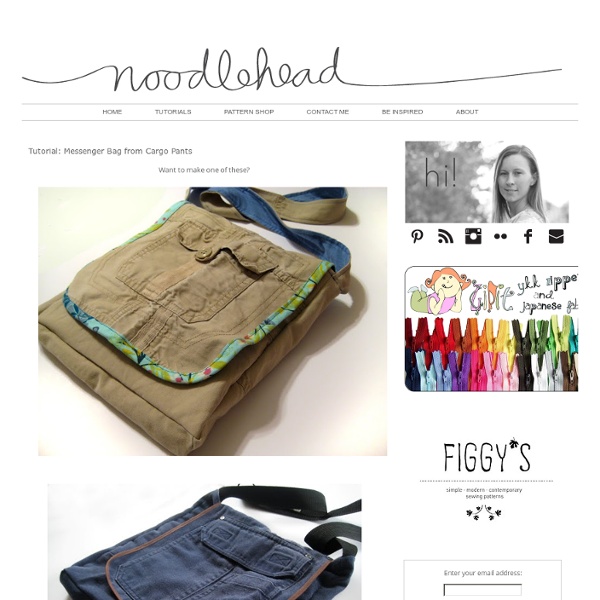Zoom
Trash
Related:



Long Overdue Fusing Plastic Bag Tutorial I realized this afternoon that I basically explain this technique to an Etsy Labs visitor at least once a day, but had never put the instructions online. So, here it is. Fusing! Plastic! Bags! What you'll needPlastic bags (thin, flimsy ones work best)Parchment paper, freezer paper or plain old copier paperIron (and your favorite ironing surface) Making it Flatten out the bag and trim the bottom seam and handles off. Turn the bag inside-out if it has printing on it. Next, run a hot iron (we set ours to "Rayon", but you will need to experiment a little to see what works for you) and keep the iron moving constantly. Peel a corner of the paper back to see if the plastic is fused together. Peel the parchment paper away from the finished plastic sheet. Here are a few more rad examples of what you can do with this stuff, courtesy of Etsy seller Eclipse Alright, y'all.
NEON STRIPED COFFEE TABLE As you can see... this table needed some help. Casey had this table all painted yellow and when it didn't live up to her expectations... she started chipping the paint away (off of the top.) Soon enough we bought some spray that made it 1000 times easier to get the paint off. With a blank surface of a table, we decided to take advantage of the situation and spice it up a little... with neon colors. I'll give you a step by step of how we did it. Start off with a stripped down table surface. Sand the table down really well. Paint the legs/ bottom of the table. When the bottom has dried, tape off the top of the edges of the top of the table. We stuck computer paper to the backside of the tape to make sure we didn't get any paint on the bottom of the table. We spray painted the top of our table gray, let it dry a little and then removed the tape and paper. For our table we wanted to do a series of diagonal stripes weaving in and out of each other.
Homemade art for sister Yesterday my parents, gramma and I went to visit Kayla at school. Her birthday is on Tuesday, but we thought it would be better to go up the weekend before. (I will post all about this on Tuesday!!) I made her 2 things, and I thought I would share the cool art I made for her. This is what you will need: 3 pairs of old glasses, a shadow box, 6 pictures and hotglue. First, place a piece of paper over the lense of the glasses and rub around the edge of the glass to trace the shape of the glass. (sorry about the awful pictures, the lighting is awful in the craft room at night!) Originally I was going to modge podge the picture to the front of the glasses, but then I decided to attach it to the bottom. After you put them on the botton, put a strip of hotglue around the lenses to keep the picture from falling out (that's hot glue) Next, attach the glasses with hot glue to a piece of scrapbook paper Put in frame Double check the glasses (in the day) for strands of hot glue. cute! Cute girl.
Recycled Can Snowman Ornament There are currently no images from other crafters. close Terms & Conditions You must enter into this Agreement if you want to submit digital images or other content to Prime Publishing through Sharing Customer Images (the "Service"). 1) Eligibility. 2) Definitions. 3) License Grant for Materials. 4) Removal of Materials. 5) License for Name, Trademarks and Likenesses. 6) Specifications and Guidelines. 7) Representations, Warranties and Indemnities. 8) Restrictions. 9) No Obligation. 10) Changes to Agreement. 11) Prime Publishing Intellectual Property. 12) Communications. 13) Waiver. 14) Disclaimer. 15) Miscellaneous. Sharing Your Own Images Who can share images? You! What should I share? Please share images that will help other visitors. Do include captions for your images. What shouldn't I share? Behave as if you were a guest at a friend's dinner party: please treat the Prime Publishing community with respect. The same guidelines apply to your captions and notes. Where will my image appear?
Faux Tin Tiles Tutorial Recycled crafts are one of my specialties. Embossing disposable cookie sheets is an easy technique and creates amazing art. Beautiful faux tin tiles! This is my second recycled craft idea using disposable cookie sheets!. For this project I used: 2 disposable aluminum cookie sheetsFree patterns from my pattern page* A knitting needle Paintbrush Various metallic acrylic paintsSpray primer A cork bulletin board Thumb tacks Are you new to the Sitcom? Begin by measuring out and cutting (3 ea.) 7″ squares from each cookie sheet. Use the scissors to clip a notch in each corner. I then drew out some patterns on paper. Here the metal tile is shown with the pattern scored into it. Once the piece is indented to your satisfaction, it is time to paint it. Once all the indentions were painted, I added a base color to the raised areas. I used the same color scheme for each tile, so that they all worked together. There are many ways to display your finished tiles. Signing you up!